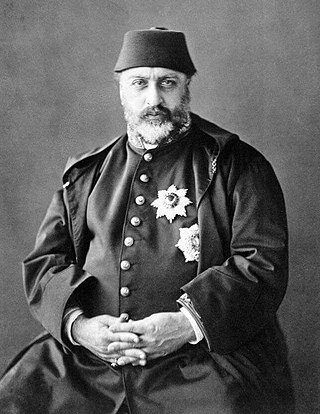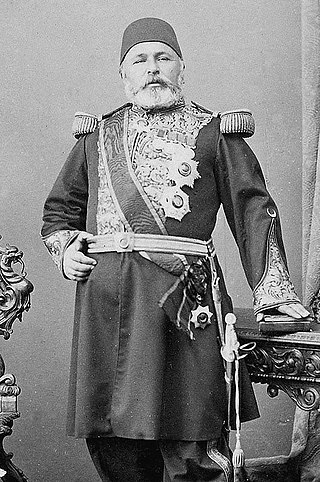On 30 May 1876, a government coup occurred in the Ottoman capital of Istanbul, which resulted in the dethronement of the Ottoman Sultan Abdulaziz, and subsequently, the appointment of Murad V as the Sultan.
Contents

On 30 May 1876, a government coup occurred in the Ottoman capital of Istanbul, which resulted in the dethronement of the Ottoman Sultan Abdulaziz, and subsequently, the appointment of Murad V as the Sultan.

In the last period of Abdulaziz's reign, the economic situation was getting worse. In 1875, uprisings against the Ottoman Empire broke out in Serbia, the Aegean Islands, Egypt, Montenegro, Romania and Bosnia-Herzegovina. The Bulgarian Revolts, which broke out in the Panagurishte region in April 1876, spread to the entire Sredna Gora region. Around 1,000 Muslim people living in the region were killed by the rebellious Bulgarians. [1] As a result, reciprocal massacres took place between Bulgarians and Caucasian Muslims, such as Circassians and Abazas, who were expelled from the Caucasus by the Russian Empire and forced to migrate to the region. These massacres were evaluated as if they were committed against the Bulgarians unilaterally in Europe, causing a negative atmosphere around the Ottoman Empire.
Thereupon, the European countries' various interventions against the Ottoman Empire created discomfort among the Ottoman people. On May 9, 1876, students in the Fatih district of Istanbul protested. The number of demonstrators reached 5,000 in a short time. [2] On 12 May, Grand Vizier Mahmut Nedim Pasha was dismissed and Mehmed Rüşdi Pasha came in his place. In addition, Hasan Hayrullah Efendi became the sheikh al-Islam instead of Hasan Fehmi Efendi. Hüseyin Avni Pasha was also made a serasker. But the demonstrations did not end. On 17 May, demonstrations were held again in Fatih and in Beyazıt squares.

One day before the coup, on May 29, 1876, the head of the Young Ottoman secret society, Midhat Pasha, serasker Hüseyin Avni Pasha, War School Minister Süleyman Pasha, Council of Military Chief Ahmed Pasha received a fatwa from the new Şeyhülislam Hasan Hayrullah Efendi for the removal of the Sultan. Everything was ready for the coup to take place the next day.

On 30 May, the students of the Military Academy took action under the command of Süleyman Pasha, and the soldiers in the Taşkışla and Gümüşsuyu barracks were under the command of the Istanbul army commander, Refik Pasha. Madrasah students also joined the soldiers. Dolmabahçe Palace was surrounded. Abdulaziz, who was dethroned, was removed from the palace in a boat. In his place, Murad V was declared the Ottoman Sultan.
The ousted sultan, who was detained in Feriye Palace, was found dead on 4 June with his wrists slit. Neşerek Kadın Efendi, one of Abdülaziz's wives, passed away on 11 June. Neşerek Hanım's brother, Circassian Hasan, who held these state officials responsible for the events that dethroned Abdülaziz, went to Midhat Pasha's mansion on 15 June 1876 and raided a government meeting. He killed Serasker Hüseyin Avni Pasha and Foreign Minister Mehmed Raşid Pasha. He also chased Midhat and Ahmed Pashas to kill them. 5 people were murdered until Circassian Hasan was caught. After this incident, the mental health of Sultan Murad V, who was already depressed, got worse. On August 31, a fatwa was taken from the sheikh al-Islam again, and he was dethroned and replaced by Abdul Hamid II. [3] [4]

Abdulaziz was the 32nd sultan of the Ottoman Empire and reigned from 25 June 1861 to 30 May 1876, when he was overthrown in a government coup. He was a son of Sultan Mahmud II and succeeded his brother Abdulmejid I in 1861.

Mehmed III was Sultan of the Ottoman Empire from 1595 until his death in 1603. Mehmed was known for ordering the execution of his brothers and leading the army in the Long Turkish war, during which the Ottoman army was victorious at the decisive Battle of Keresztes. This victory was however undermined by some military losses such as in Gyor and Nikopol. He also ordered the successful quelling of the Jelali rebellions. The sultan also communicated with the court of Elizabeth I on the grounds of stronger commercial relations and in the hopes of England to ally with the Ottomans against the Spanish.

Murad V was the Sultan of the Ottoman Empire who reigned from 30 May to 31 August 1876. The son of Abdulmejid I, he supported the conversion of the government to a constitutional monarchy. His uncle Abdulaziz had succeeded Abdulmejid to the throne and had attempted to name his own son as heir to the throne, which spurred Murad to participate in the overthrow of his uncle. However, his own frail physical and mental health caused his reign to be unstable and Murad V was deposed in favor of his half-brother Abdul Hamid II after only 93 days.

Ahmed Midhat Şefik Pasha was an Ottoman politician, reformist and statesman. He was the author of the Constitution of the Ottoman Empire.

The Young Ottomans were a secret society established in 1865 by a group of Ottoman Turkish intellectuals who were dissatisfied with the Tanzimat reforms in the Ottoman Empire, which they believed did not go far enough. The Young Ottomans sought to transform the Ottoman society by preserving the Empire and modernizing it along the European tradition of adopting a constitutional government. Though the Young Ottomans were frequently in disagreement ideologically, they all agreed that the new constitutional government should continue to be at least somewhat rooted in Islam. To emphasize "the continuing and essential validity of Islam as the basis of Ottoman political culture" they attempted to syncretize an Islamic jurisprudence with liberalism and parliamentary democracy. The Young Ottomans sought for new ways to form a government like the European governments, especially the constitution of the Second French Empire. Among the prominent members of this society were writers and publicists such as İbrahim Şinasi, Namık Kemal, Ali Suavi, Ziya Pasha, and Agah Efendi.
Hoca Sadeddin Efendi was an Ottoman Islamic scholar, theologian, official, and historian, a teacher of the future Ottoman sultan Murad III. His name may be transcribed variously, e.g. Sa'd ad-Din, Sa'd al-Din, Sa'düddin, or others. He was also called by the title of "Câmi'-ür Riyâseteyn".

The First Constitutional Era of the Ottoman Empire was the period of constitutional monarchy from the promulgation of the Ottoman constitution of 1876, written by members of the Young Ottomans, that began on 23 December 1876 and lasted until 14 February 1878. These Young Ottomans were dissatisfied by the Tanzimat and instead pushed for a constitutional government similar to that in Europe. The constitutional period started with the dethroning of Sultan Abdulaziz. Abdul Hamid II took his place as Sultan. The era ended with the suspension of the Ottoman Parliament and the constitution by Sultan Abdul Hamid II, with which he restored his own absolute monarchy.

Şehzade Yusuf Izzeddin Efendi was an Ottoman prince, the eldest son of Sultan Abdulaziz and his first consort Dürrinev Kadın.
Pertevniyal Valide Sultan, was the thirteenth consort of the Ottoman Sultan Mahmud II, and Valide sultan of Sultan Abdulaziz.
Şevkefza Sultan, also known as Şevkefza Kadın, was a consort of Sultan Abdulmejid I of the Ottoman Empire. She held the position of Valide Sultan from 30 May 1876 to 31 August 1876, when her son Şehzade Murad ascended the throne as Murad V.
Neşerek Kadın, born Nesrin Zevş-Barakay Hanim, was a consort of Sultan Abdulaziz of the Ottoman Empire.

The following outline is provided as an overview of and topical guide to the Ottoman Empire:

Mehmed Riza Pasha or Serasker Riza Pasha was an Ottoman military commander. He reached the rank of Serasker, which was the highest military rank of the Ottoman Empire. He participated in the Russo-Turkish War (1877–78).

Şehzade Mehmed Selaheddin Efendi was an Ottoman prince, the only survived son of Sultan Murad V, and his second consort Reftarıdil Kadın.

Hüseyin Avni Pasha was an Ottoman governor-general and statesman. He was Grand Vizier of the Ottoman Empire from 15 February 1874 to 26 April 1875. He was killed by Çerkess Hassan the younger brother of Neşerek Kadın Efendi, who accused him of the murder of Ottoman Sultan Abdülaziz, on 15 June 1876 during a cabinet meeting of Ottoman Sultan Murad V at the residence of Midhat Pasha near Beyazıt in Fatih, Istanbul. The foreign affairs minister Mehmed Rashid Pasha was also killed in the attack.
Emine Sultan was an Ottoman princess, the daughter of Ottoman Sultan Abdulaziz and Neşerek Kadın.

Şehzade Selim Süleyman was an Ottoman prince, the son of Sultan Abdulmejid I, and one of his consorts Serfiraz Hanım.
Şehzade Mehmed Şevket Efendi was an Ottoman prince, the son of Sultan Abdulaziz and Neşerek Kadın.
Şehzade Mahmud Celaleddin Efendi was an Ottoman prince, son of Sultan Abdulaziz and his consort Edadil Kadın.